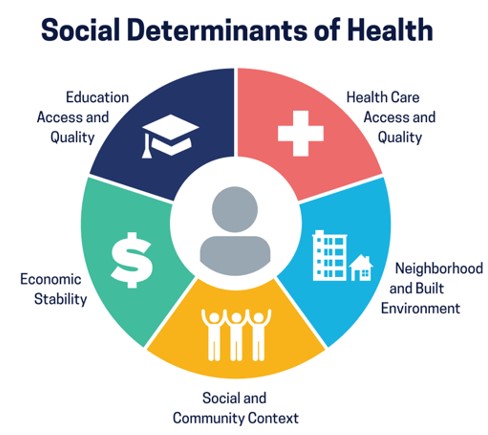Adverse Childhood Experiences (ACE) in Minnesota
Contact Info
ACEs and Social Determinants of Health
The Centers for Disease Control and Prevention (CDC) describes the social determinants of health as “the conditions in which people are born, grow, work, live, and age, and the wider set of forces and systems shaping the conditions of daily life. These forces and systems include economic policies and systems, development agendas, social norms, social policies, racism, climate change, and political systems.”
Social Determinants of Health (SDOH) are commonly grouped into five areas: Economic Stability, Education Access and Quality, Health Care Access and Quality, Social and Community Context, and the Neighborhood and Built Environment (see Figure 1). SDOH have a major impact on people’s lifelong health, well-being, and quality of life. The negative or positive impact of SDOH can accumulate over a lifetime, alter a person’s life course, and be passed down to future generations.
ACEs and SDOH are closely linked, some SDOH can be a source of childhood adversity and toxic stress, like experiencing housing insecurity or homelessness. The social conditions that a person or family experiences can shape or mitigate the pile up of stress. For example, unemployment and limited access to health care, can contribute to the experience of stress. Poor social conditions can also put children and families in vulnerable situations that create additional opportunity to experience adversity and traumatic situations.
Figure 1: Social Determinants of Health

While the figure above shows five common elements, we know that SDOH do not always fall into discrete categories. One factor that will influence much of these is climate change. Climate change is a global SDOH whose impact will be felt across many areas of community health and wellbeing.
SDOH and Health Inequities
SDOH contribute to wide health disparities and inequities. Health inequities are systematic differences in health outcomes that could be considered unfair or potentially avoidable. The World Health Organization defines health inequities as “differences in health status or in the distribution of health resources between different population groups, arising from the social conditions in which people are born, grow, live, work and age.” SDOH are so impactful on health inequities that improving SDOH is a priority area of the Healthy People 2030 plan.
For example, people who don't have access to employment that pays a living wage are less likely to be able to afford healthy food. That raises their risk of health conditions like heart disease, diabetes, and obesity — and even lowers life expectancy relative to people who do have access to healthy foods. The lack of access to well-paying employment can be impacted by many things, such as fewer educational opportunities and structural racism impacting hiring decisions.
In the 2014 MDH Health Equity Report, structural racism is cited as the main source of health inequities. Structural racism is when decisions are made on a system-wide level that benefit white people and create chronic adverse outcomes for Black, Indigenous and other people of color (BIPOC). Structural racism is a SDOH, and it shapes all the SDOH factors.
In Minnesota, structural racism has prevented BIPOC communities from having access to the resources needed to be healthy. Poverty, ACEs, intergenerational trauma, and intergenerational substance use are all SDOH influenced by structural racism. The health inequities experienced by BIPOC communities, as a result of SDOH and structural racism, have resulted in disparities in ACEs between different racial groups. In 2022, 48% of students in Minnesota experienced one or more ACEs. Children from communities that have experienced structural racism and other injustices tend to report more ACEs. To learn more about disparities in ACEs between different communities, please visit the ACEs dashboard.